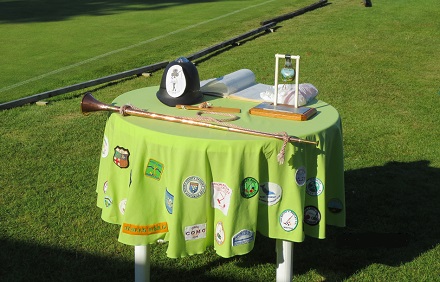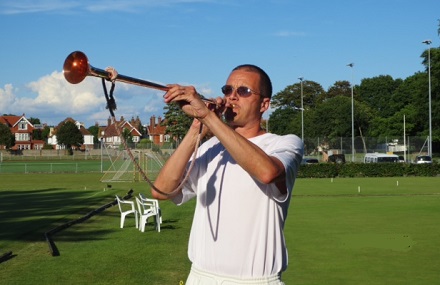

|
Back to |
| The Front Page |
| News & Features |

|
Time for croquet in England and America |
||||||||
|
by Bob Alman with Roger Wood photos as credited
|
||||||||
|
||||||||
Is the game designed to go to the peg, or not?
Just imagine a marathon race with a time limit. Does that make any sense? Well, yes, it could, if you have assigned clock-times for associated features of the event--such as catering and speeches and awards. Having a time limit for a marathon sounds sort of reasonable, just as having a time limit for croquet makes a kind of sense, sometimes, within the context of a tournament. But surely croquet, like the great game of human life, should be allowed to complete it's natural course. When I begin a croquet game, I play with the intention of pegging out. I regard any other point of view as unnatural as ingesting a chemical to end it all "before my time." The game has not been completed as designed until the peg-out.

|
I've tried to answer this question myself, at the National Croquet Center in South Florida, where as a member and "grey eminence" I like to organize and direct casual programs with educational features for each season. For the last two years, that program has featured "timeless games to the peg," for middle-and high-handicap players who, I had observed, really don't know how to play rover and seldom if ever get near the peg in tournaments or even in club play, where there are two-hour reservation limits for court time.
If the games are organized to go all the way to the peg, no clocks of any kind are necessary. Formerly, at the NCC, I used several "practice" formats, including "four-back," in which all the players after scoring the first hoop are immediately bound for four-back. The players liked these informal events and learned a lot--especially about rover play.
So for the 2016-17 season, I decided to sanction the official USCA Short Game, according to Rule 16.1 in the official USCA rule book, and wrote to USCA president Johnny Mitchell informing him and asking if he knew of any problems I might encounter by doing that. What a flurry of emails ensued!
One tournament director declared indignantly, "Without a time limit, they would play to the peg, which is not the goal in the American game. You would then wipe out time-outs, the 45-second clock, the last turns, and the countdown!" Exactly! Nuisances, all of them, if they're not necessary, and intrinsically unfair, if you look closely.
| THE FORTY-FIVE SECOND SHOT LIMIT |
|
In American Rules, you can use it both tactically and strategically. In a controlled break at the one-hour mark, the player ahead in a 75-minute game may legally take a full 40 seconds to play each shot of a controlled break and run the clock down in the course of scoring just five hoops, taking care to roquet all three of the other balls in each turn, for a total of 24 shots including the hoop bonus stroke. "Last turns" will be declared after the pegout, with the opponents separated and the remaining partner ball in a remote corner. Many who play this travesty insist that it is not only legal but ethical. The uncertainty and arbitrary nature of the human management of all those clocks alone makes it impossible to approach Perfect Justice in such a game--if only because there is no way to measure and record a human being's real "intention," an insight often noted with respect to improving the rules of various croquet games.
|
Everyone except Stuart Lawrence and Bob Alman were surprised to learn that such games had already been conducted, with results duly recorded in the USCA handicap/tracking system. Sanctioned Short Game events were organized or directed recently by Stuart Laurence, in the Northeast Region. Bob Alman had twice sanctioned timeless games (or should I say "clockless games") in the late 90's for the entire single-game knockout of the Championship Flight of the San Francisco Open. (It didn't occur to him at the time that he needed to ask, and the USCA reporting form does not say anything about whether the games are long or short, or whether clocks are used.)
After brief research, the USCA committees conceded that neither a gameclock or a shot clock is mandatory in the American Rules game. Being able to disregard all the rules dealing with time--13.7 through 13.11--actually simplifies tournament management, avoids sticky questions of fairness and cheating, and actually may result in more "expeditious play" because: (1) players will no longer use the 45-second shot limit as an "entitlement" to run down the clock; (2) players will no longer avoid running one-back and clearing opponent's deadness as a winning strategy.
Putting clocks into the game is inherently unfair
The inherent unfairness of all those clocks becomes obvious in an actual tournament situation, when players are burdened not only with trying to follow the time conventions fairly and courteously, but also concerned about being badly thought of for--for example--walking too slowly to replace a boundary ball; or pausing to think carefully about a croquet shot in a critical end-game situation, with time running down by the second. And what about the convention of stopping the clock in the last ten minutes to allow for double-banking traffic? How and when and by whom that is determined is always arbitrary. Using all those clocks in all those situations is inevitably messy, inexact, and error-prone. The pretense of precision actually creates its opposite!
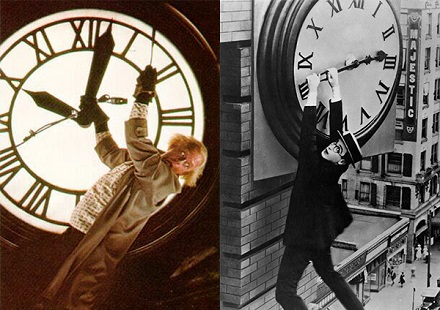
|
Why hasn't this been noticed by everyone? I say it hasn't been noticed because clocks have been a fundamental part of the croquet culture in America since the early days of the founding of the USCA in the late 1970s, when there were very few courts available and thus not nearly enough time to do a tournament or even to play a single game at a one-court venue all the way to the peg.
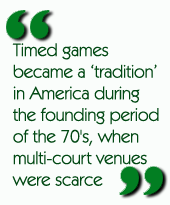 So the atrocity of time--which has long struck visiting internationals as very odd indeed, and quite comical--was never noticed by players who used the clock in every game. What started as an allowable expedient in a situation of scarcity quickly became part of the American croquet tradition, persisting long after it was necessary!
So the atrocity of time--which has long struck visiting internationals as very odd indeed, and quite comical--was never noticed by players who used the clock in every game. What started as an allowable expedient in a situation of scarcity quickly became part of the American croquet tradition, persisting long after it was necessary!
But if there's no problem in the rules with either the American Rules Short Game or the standard 26-point game without clocks, changing the established culture of the game in America won't happen overnight. Dome players and organizers, however, are leading the way when the contemporary abundance of courts at single venues allows for a parallel abundance of clock time for scheduling game periods. Games that go all the way to the peg--in either Short Games for novices or full games at top level--are becoming more common.
Making the case for timelessness
For the 26-point games in San Francisco I directed for the Championship flight, all the schedule required was giving up one of the conventional gameslots in the day, so they could all be 120 minutes, beginning at 8:00 AM with an hour break for lunch, resuming at 1:00 PM, and continuing with the single-game final at 3:00 PM. That left more than an hour of extra time if somewhere in the four-stage knockout ladder the games bogged down.
One singles game did go few minutes over two hours, but that was in the morning, so the tournament ended well before 5:00 PM. It worked, two years consecutively, in the Championship Flight. And there were no complaints. Everyone not playing could simply watch and appreciate the play--and the players could enjoy their games unencumbered by clock-related worry, guilt, and distraction.
And yet....the San Francisco Opens of 1999 and 2000 have been the only "serious" tournaments to be played in this fashion for the entire knockout ladder.
More recently Stuart Lawrence has run the Berkshire Invitational's second flight singles and first and second flight doubles as 14-point games, but with a clock: 75-minute games for singles and 90 minutes for doubles; and in club tournaments in New York.
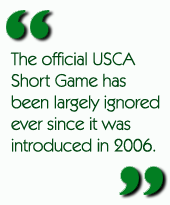 Lawrence does not approve of the "timeless" aspect for most tournasment play, sharing the desire of most practical tournament directors to "control the schedule." But he confessed that the North East Regional final was played with no time limit in both flights, and observes that the innovation did not affect the likelihood of him or his opponent winning. He won the final himself in 45 minutes. Like all the top players in America, he plays the 26-point game as a race to the peg, not a race against the clock.
Lawrence does not approve of the "timeless" aspect for most tournasment play, sharing the desire of most practical tournament directors to "control the schedule." But he confessed that the North East Regional final was played with no time limit in both flights, and observes that the innovation did not affect the likelihood of him or his opponent winning. He won the final himself in 45 minutes. Like all the top players in America, he plays the 26-point game as a race to the peg, not a race against the clock.
Lawrence reports that the Short Games he has directed have been generally well received and notes that players who won would have been likely to win a 26-point game with the same time limit.
The USCA adopted an official Short Game in 2006 and it has largely been ignored ever since. In this instance, Americans really can learn something from the international culture of Association Croquet and begin to organize tournament formats that allow for the players to compete to get to the peg first and win. Playing "virtually" timeless games is already the standard in high-level play of Association Croquet everywhere, including the US. (Time is imposed rarely and "only when absolutely necessary to control the schedule.")
Spectators at any high-level American Rules games expect to see them played to the peg. The players would be embarrassed to do anything else. And surely the high handicap players would be delighted to get to the peg and learn to play an effective end-game once in a while--which they can do in the Short Game.
Fine-tuning top-level Association Croquet over one weekend As late as the 80s, English clubs offered a mixture of week-long Association Croquet events run at a leisurely pace attractive to the moneyed classes and contested mostly by elderly players; along with more intense three-days tournaments for players of all ages and classes. By 2016 the few remaining week-longs, such as South of England Week, were struggling to get enough entrants to keep them going, while the English fixtures list grew longer each year with top-class two-day events, allowing almost anyone to enter without losing work time. Roger Wood and the late Roy Wallis are among those who responded successful to the changing times. They created one of the oldest Advanced Play two-day events on the calendar in 1978--the Compton Open Weekend--and it still attracts a quality entry. Competitors from far away can fly into the nearby Gatwick Airport. Now 73 years old, Wood retired from the Royal Greenwich Observatory, where he gained a PhD in astronomy and where, in 1967, he first discovered croquet on the lawns in the formal gardens of Herstmonceux Castle. Wood has refined the management of Compton Open Weekend for decades and keeps detailed records of every match since it started. He and the participants relish the quirky aspects of the event--especially the trophies--which continue to burnish the event's venerable reputation. How to maximize playing time for everyone With double banking and no one sitting out, the maximum number of players on Compton's five lawns would ideally be 20--but Wood's initial plan in 1978 of an all-play-all block didn't maximize the number of games playable, not even with England's long summer evenings. Wood wanted the luxury of single-banking for semi-finalists and finalists.
The first format, Wood recalls, was to take 14 competitors divided into two round-robin blocks with each of the winners of the two blocks playing each other to determine the overall winner. After only two years, the first major improvement was a switch to a knockout as the main event--single games in the early rounds, with best-of-3 in the semis and the final--and a flexible Swiss for the consolation round to allow more games for players knocked out early on. Faster players could fit in extra rounds in the Swiss instead of sitting around waiting for their slower companions to finish. The overall aim of the COW has always been to give contestants as much play as possible over one weekend and to emerge with a definitive winner, achieved with block play-offs and knockouts, and the Swiss format calls for special management skills: "For the manager life can sometimes get a little fraught when a whole lot of games finish close together and players are clamouring to get on with the next one," Wood observes. So Wood developed his own software tools to allow him to enter results quickly and thereby generate a chart showing at a glance who has played whom and a full list of results in the format required for automatic input to Chris Williams's croquet records database. All these elements combine to produce the ultimate efficiency required. Time limits have been imposed no more than a couple of times over the years when absolutely necessary to finish the event. A picture of perfection After so many years of perfecting the Compton Open Weekend, Wood doesn't see a lot that needs to be changed. Players like the intense schedule, the venue, the format and the catering (simple salad lunches with cheese French baguettes and fruit together with real ale from the nearby brewery in Lewes).
Wood's best measure of success is always the number of players who return in subsequent years. One player has competed 20 times and many others have made more than 10 appearances. A total of 167 players have competed to date, Wood notes with his typical statistical precision. Wood sums up his record: "I think the format has stood the test of time and I hope that the calendar slot is sufficiently well established that the event will continue to appeal for many more years to working players whose leisure time is limited. We've never sought or been offered any sponsorship--the income from entry fees and catering is quite sufficient. "I've now been managing it for nearly 40 years and, even though it seems to be regarded as 'my baby', I quite realize that I'll have to hand it over to a younger person in the next few years." In a perfect world, the next manager will have been able to learn from the experience of the one before.
|
| Back to Top | Copyright © 1996-2024 Croquet World Online Magazine. All rights reserved. |
